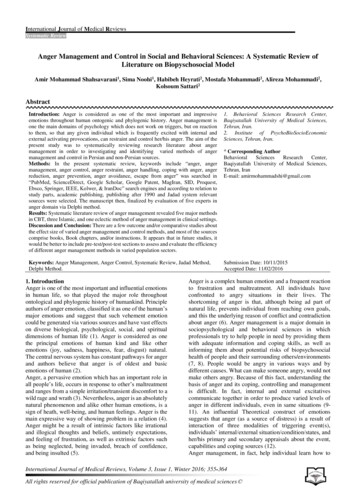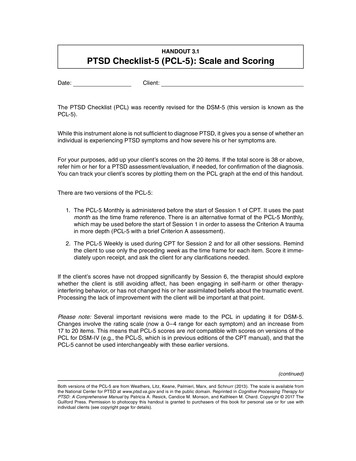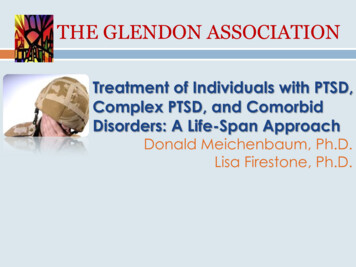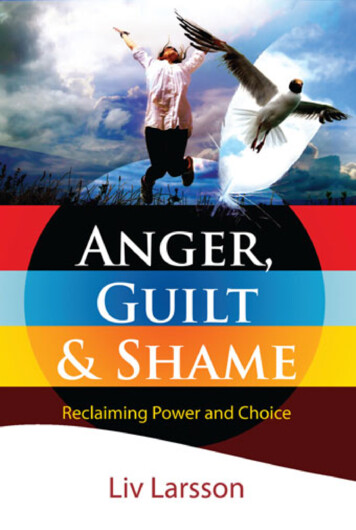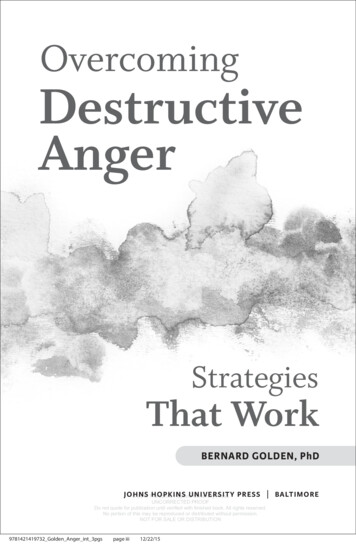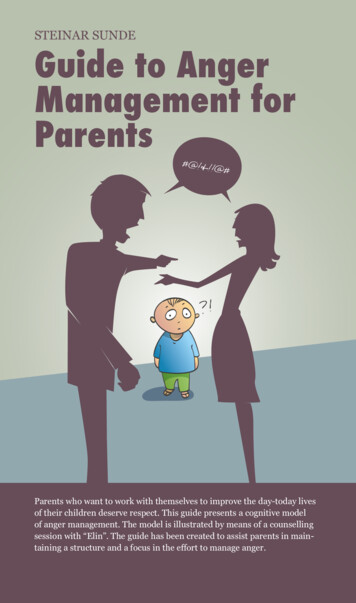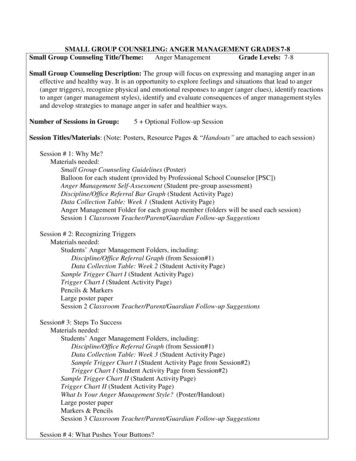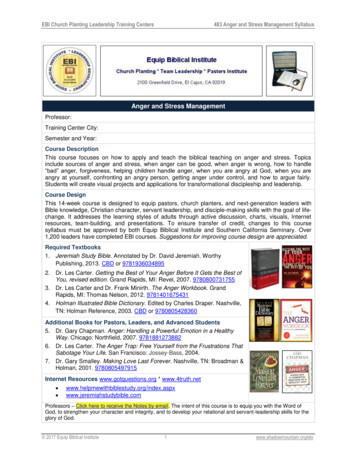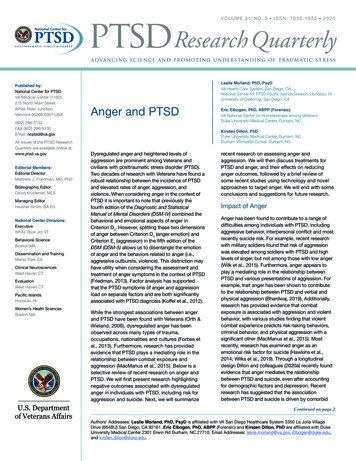
Transcription
V O L U M E 3 1 / N O . 3 I S S N : 1 0 5 0 -1 8 3 5 2 0 2 0Research Quarterlyadvancing science and pr omoting unders tanding of traum atic stressPublished by:National Center for PTSDVA Medical Center (116D)215 North Main StreetWhite River JunctionVermont 05009-0001 USALeslie Morland, PhD, PsyDVA Health Care System, San Diego, CANational Center for PTSD Pacific Islands Division, Honolulu, HIUniversity of California, San Diego, CAAnger and PTSD(802) 296-5132FAX (802) 296-5135Email: ncptsd@va.govAll issues of the PTSD ResearchQuarterly are available online at:www.ptsd.va.govEditorial Members:Editorial DirectorMatthew J. Friedman, MD, PhDBibliographic EditorDavid Kruidenier, MLSManaging EditorHeather Smith, BA EdNational Center Divisions:ExecutiveWhite River Jct VTBehavioral ScienceBoston MADissemination and TrainingMenlo Park CAClinical NeurosciencesWest Haven CTEvaluationWest Haven CTPacific IslandsHonolulu HIWomen’s Health SciencesBoston MAEric Elbogen, PhD, ABPP (Forensic)VA National Center on Homelessness among VeteransDuke University Medical Center, Durham, NCKirsten Dillon, PhDDuke University Medical Center, Durham, NCDurham VA Health Center, Durham, NCDysregulated anger and heightened levels ofaggression are prominent among Veterans andcivilians with posttraumatic stress disorder (PTSD).Two decades of research with Veterans have found arobust relationship between the incidence of PTSDand elevated rates of anger, aggression, andviolence. When considering anger in the context ofPTSD it is important to note that previously thefourth edition of the Diagnostic and StatisticalManual of Mental Disorders (DSM-IV) combined thebehavioral and emotional aspects of anger inCriterion D3. However, splitting these two dimensionsof anger between Criterion D4 (anger emotion) andCriterion E1 (aggression) in the fifth edition of theDSM (DSM-5) allows us to disentangle the emotionof anger and the behaviors related to anger (i.e.,aggressive outbursts, violence). This distinction mayhave utility when considering the assessment andtreatment of anger symptoms in the context of PTSD(Friedman, 2013). Factor analysis has supportedthat the PTSD symptoms of anger and aggressionload on separate factors and are both significantlyassociated with PTSD diagnosis (Koffel et al., 2012).While the strongest associations between angerand PTSD have been found with Veterans (Orth &Wieland, 2006), dysregulated anger has beenobserved across many types of trauma,occupations, nationalities and cultures (Forbes etal., 2013). Furthermore, research has providedevidence that PTSD plays a mediating role in therelationship between combat exposure andaggression (MacManus et al., 2015). Below is aselective review of recent research on anger andPTSD. We will first present research highlightingnegative outcomes associated with dysregulatedanger in individuals with PTSD, including risk foraggression and suicide. Next, we will summarizerecent research on assessing anger andaggression. We will then discuss treatments forPTSD and anger, and their effects on reducinganger outcomes, followed by a brief review ofsome recent studies using technology and novelapproaches to target anger. We will end with someconclusions and suggestions for future research.Impact of AngerAnger has been found to contribute to a range ofdifficulties among individuals with PTSD, includingaggressive behavior, interpersonal conflict and mostrecently suicide risk. For example, recent researchwith military soldiers found that risk of aggressionwas elevated among soldiers with PTSD and highlevels of anger, but not among those with low anger(Wilk et al., 2015). Furthermore, anger appears toplay a mediating role in the relationship betweenPTSD and various presentations of aggression. Forexample, trait anger has been shown to contributeto the relationship between PTSD and verbal andphysical aggression (Bhardwaj, 2019). Additionally,research has provided evidence that combatexposure is associated with aggression and violentbehavior, with various studies finding that violentcombat experience predicts risk-taking behaviors,criminal behavior, and physical aggression with asignificant other (MacManus et al., 2015). Mostrecently, research has examined anger as anemotional risk factor for suicide (Hawkins et al.,2014; Wilks et al., 2019). Through a longitudinaldesign Dillon and colleagues (2020a) recently foundevidence that anger mediates the relationshipbetween PTSD and suicide, even after accountingfor demographic factors and depression. Recentresearch has suggested that the associationbetween PTSD and suicide is driven by comorbidContinued on page 2Authors’ Addresses: Leslie Morland, PhD, PsyD is affiliated with VA San Diego Healthcare System 3350 La Jolla VillageDrive (664BU) San Diego, CA 92161. Eric Elbogen, PhD, ABPP (Forensic) and Kirsten Dillon, PhD are affiliated with DukeUniversity Medical Center 2301 Erwin Rd Durham, NC 27710. Email Addresses: leslie.morland@va.gov, Elbogen@duke.edu,and kirsten.dillon@duke.edu.
Continued from coverdepression (e.g., DeBeer et al., 2016), so it is notable that the studiespresented here all covaried for depression diagnosis or symptomseverity, suggesting that anger uniquely contributes to suicide risk inthe context of PTSD (Dillon et al., 2020a; Hawkins et al. 2014; Wilkset al., 2019). Overall, there is evidence that among individuals withPTSD, comorbid dysregulated anger significantly increases risk forengaging in both interpersonal and self-directed aggression.Furthermore, increased anger appears to play a mediating rolebetween PTSD and these negative outcomes (e.g., Bhardwaj, 2019;Dillon et al., 2020b). These studies highlight the importance ofassessing and treating comorbid anger in individuals with PTSD.Assessment of AngerIn their review of tools for assessing posttraumatic anger, Taft andcolleagues (2012) note that the U.S. Department of Defense (DoD)and the Department of Veterans Affairs (VA) have recommendeduse of standardized anger measures, specifically the STAXI(State-Trait Anger Expression Inventory). The STAXI-2 is comprisedof 57 items and includes both state and trait anger scales, theformer evaluating an individual’s present experience of anger andthe latter evaluating an individual’s anger disposition over thecourse of one’s life. Additionally, the STAXI-2 measures angerexpression, anger suppression, and anger control. The STAXI hasbeen used in veteran and military samples (Mackintosh et al., 2017;Van Voorhees et al., 2019) and shows at least adequate discriminantvalidity (Taft et al., 2012). One consideration is that while it has beenwidely used in research, the STAXI involves a comprehensive angerassessment, which may not be feasible for time-pressuredhealthcare providers to complete in clinical practice.For this reason, a shorter called the Dimensions of Anger Scale(DAR-5) has been developed by Forbes et al. (2014). The DAR-5consists of 5 items that measure, for the past four weeks, anindividual’s level of anger frequency, intensity, duration, antagonismtoward others, and interference with social functioning (Forbes etal., 2014). In a sample of N 164 male Veterans, the DAR-5demonstrated high internal reliability (Cronbach’s alpha .86).Importantly, the DAR-5 had strong convergent validity with theSTAXI (all correlations were p .001 except for State Anger wherep .002), meaning the DAR-5 can be used as a valid screening andassessment measure of anger among Veterans with PTSD. Of note,Forbes et al. (2014) found a clinical cut-off score of 12 on theDAR-5 based on this study and previous research, furthersupporting its use in clinical practice.Another aspect of anger assessment that should be considered inthe context of PTSD is whether anger stems from the trauma itself(i.e., does the assessment target post-traumatic anger in particular).Toward this end, Sullivan et al., (2019) developed a 19-item Traumarelated Anger Scale. This scale first prompts individuals to thinkabout a stressful or traumatic event and then asks them to rate howthey function after the event. Factor analysis revealed fourdimensions of post-traumatic anger: 1) anger giving a sense ofcontrol or energy; 2) thought and emotional avoidance relating toanger; 3) anger in response to threat; and 4) anger in response topity. Although it was validated in N 435 undergraduate students,the Trauma-related Anger Scale was psychometrically sound, withexcellent internal consistency and good evidence of validity, andthus shows promise as a tool for potential use in patients with PTSD.At a minimum, the Trauma-related Anger Scale is beneficial forPAGE 2reminding the field and clinicians that some anger domains maystem from trauma and PTSD and may be different from anger anindividual experienced beforehand or throughout their whole life(see Olatunji et al., 2010).Anger measures reviewed thus far largely focus on assessing theemotional aspects of anger. With respect to assessing aggressionor violent behavior, a 5-item trauma-informed tool called theViolence Screening and Assessment of Needs (VIO-SCAN) wasdeveloped to assess violence in the context of PTSD and anger formilitary veterans (Elbogen et al., 2014). The VIO-SCAN instrumentqueries about PTSD accompanied by frequent experiences ofanger, as well as about personally witnessing someone in combatbeing seriously wounded or killed. The instrument also asks aboutfinancial stability, alcohol misuse, and a history of violence orcriminal arrests. Using two independent sampling frames (nationalrandom sample survey of 1,090 veterans and in-depthassessments of 197 dyads of veterans and collateral informants),the VIO-SCAN yielded area-under-the-curve (AUC) statisticsranging from .74 - .80, indicating large effect sizes in analysespredicting violence. The VIO-SCAN is not a comprehensiveviolence risk assessment tool and does not fully replace informedclinical decision-making. Instead, the screen provides clinicianswith a rapid, systematic method to review empirically supportedrisk factors and to collaboratively develop a plan to reduce riskand increase successful reintegration in the community.Residual Anger Following PTSD TreatmentWhile evidence-based treatments for PTSD also reduce anger,there is often significant residual anger. In a recent study examiningchanges in anger and aggression after treatment for PTSD amongactive duty servicemembers, Miles and colleagues (2019) foundsmall to moderate reductions in state anger and aggression. Themajority of servicemembers continued to endorse state anger(78%) and psychological aggression (93%) at post treatment andreductions in PTSD were only moderately correlated withreductions in anger and aggression.Schnurr and Lunney (2019) examined residual PTSD symptoms infemale Veterans and servicemembers following prolonged exposure(PE) or present-centered therapy (PCT) for PTSD. Results highlightedthe persistence of problematic anger in this population. Even amongthose who recovered from PTSD, irritability/anger was the most likelysymptom to remain (60.7% still endorsed at post-treatment). Thisfinding was similar to Larsen and colleagues (2019) who found thatirritability/anger was among the highest remaining symptom atposttreatment for women who completed PTSD treatment. Takentogether, these studies suggest that additional treatment for angermay be warranted after completing PTSD treatment.Anger Treatment Studies in PTSD SamplesThe majority of anger treatment research for individuals with PTSDhas been conducted with Veteran samples using a cognitivebehavioral therapy (CBT) approach. One intervention for anger thathas been used widely with veterans is a 12-session group CBTprotocol that was developed by the Substance Abuse and MentalHealth Services Administration over 20 years ago but recentlyupdated (SAMHSA, 2019). This anger management treatmentuses relaxation as well as cognitive and communication skillsinterventions to help participants develop coping strategies toP T S D R E S E A R C H Q U A R T E R LY
control their anger. Delivered in-person or via videoconferencing, ithas produced clinically significant reductions in anger symptomsamong Veterans with PTSD (Kalkstein et al., 2018; Mackintosh et al.,2017; Morland et al., 2010).Despite evidence that CBT effectively reduces anger in Veterans, fewstudies have included a control group; however, Shea andcolleagues (2013) conducted a randomized pilot study thatcompared a CBT-based individual anger management interventionwith a supportive intervention. Among male Iraq and Afghanistan warVeterans with anger problems and PTSD hyperarousal symptoms,they found that CBT led to greater improvements in anger outcomesand interpersonal and social functioning than supportive therapy(Shea et al., 2013). More recently, Van Voorhees and colleagues(2019) compared group CBT with group PCT in Veterans with PTSD.Participants exhibited large anger reductions, with no differencesbetween treatment modalities. Notably, this small pilot study was thefirst anger management study for Veterans to include women,despite evidence that women Veterans experience similar levels ofanger. Among women participants (n 11), there was significantlyless improvement in anger and all of the women assigned to the CBTarm dropped out of treatment, expressing dissatisfaction with thistreatment modality (Van Voorhees et al., 2019).Regarding mechanisms of action contributing to anger outcomes,Mackintosh and colleagues (2014) conducted secondary analysis ofa group CBT trial (Morland et al., 2010) and found that improvementsin arousal calming skills, but not development of cognitive copingand behavioral control skills, were associated with reduction in angersymptoms (Mackintosh et al., 2014). Further, arousal calming skillsfacilitated participants’ ability to use other anger regulation skills.Given the importance of arousal calming skills in reducing anger,approaches that prioritize these skills may be particularly useful forVeterans with PTSD and problematic anger. One such treatment iscompassion focused therapy (CFT). In a recent open label pilot studyof group CFT among Veterans with PTSD and problematic anger,participants exhibited decreased anger symptoms followingtreatment, with small to medium effect sizes (Grodin et al., 2019).Novel Approaches for Treating Anger in PTSDNovel approaches and delivery methods for anger treatmentsmay be warranted to enhance treatment engagement andeffectiveness. For example, the VA has developed a free,self-help anger treatment, based on the 12-session SAMHSAprotocol entitled Anger & Irritability Management Skills (AIMS;Greene et al., 2014). AIMS is self-paced and can be accessedon any device that has internet access.Mackintosh and colleagues (2017) investigated whether the additionof a mobile application to group CBT for anger would enhanceoutcomes. In this trial, half of the Veterans with PTSD were randomlyassigned to use a mobile application designed to support the grouptreatment by enabling skill practice, monitoring of symptoms, andusing psychophysiological sensor data. Overall, the group CBT ledto large reductions across outcomes. The use of the app did not leadto greater improvements but did appear to facilitate homeworkcompletion and increase treatment engagement compared to thosewho were assigned to group treatment only (attrition rate was 7% vs.20%), although this difference did not reach statistical significance.VOLUME 31/NO. 3 2020Interventions to target specific processes central to informationprocessing theories of anger in PTSD may also be usefuladjunctive treatments. One such process is the tendency tointerpret ambiguous interpersonal situations as hostile, known asthe hostile interpretation bias (HIB). Dillon and colleagues (inpress) recently piloted a computer-based interpretation biasmodification intervention for Veterans with PTSD. In this small pilotstudy, Veterans experienced large reductions in HIB and angerafter completing eight 15-minute sessions of computer-basedtreatment. This intervention is currently being developed as amobile intervention for Veterans with PTSD.Conclusions and Future DirectionsDysregulated anger has consistently been associated with PTSD,with the strongest associations found among military samples.Anger in PTSD is associated with interpersonal conflict,aggressive behavior, and suicide risk. While there is evidence thatPTSD treatments reduce anger, there is often significant residualanger after treatment completion. Cognitive behavioral therapy foranger may be effective to reduce PTSD-related anger in veterans,though additional research is needed to better understand angerin women with PTSD.Treatments for anger in PTSD, while leading to significantreductions on some anger outcomes need further development inorder to maximize clinical and functional outcomes. It will beimportant in future research to develop evidence-based treatmentsgrounded in theory to further our understanding and treatment ofanger in PTSD across multiple trauma populations. Someresearchers have applied technology and other novel approachesto improve access to and effectiveness of anger treatments.Additional research in these areas may help to improve thetreatment and quality of life of individuals with PTSD. Furtherresearch is needed to examine the relative contributions of PTSD,depression, and anger on suicide risk. Additionally, it will beimportant to evaluate whether reducing anger among individualswith PTSD leads to reductions in behavioral aggression and suiciderisk, as well as better functional outcomes and quality of life.FEATURED ARTICESBhardwaj, V., Angkaw, A. C., Franceschetti, M., Rao, R., & Baker, D.G. (2019). Direct and indirect relationships among posttraumaticstress disorder, depression, hostility, anger, and verbal andphysical aggression in returning veterans. Aggressive Behavior,45(4), 417–426. doi:10.1002/ab.21827 Hostility, anger, andaggression are conceptually related but unique constructs found tooccur more often among veterans with posttraumatic stress disorder(PTSD) than among civilians or veterans without PTSD. However,the pathways between PTSD, depression, hostility, anger, andaggression have not been comprehensively characterized. Therefore,drawing on a sample of returning Operation Enduring Freedom/Operation Iraqi Freedom combat veterans ( N 175; 95% male;mean age 30 years), this study sought to examine the direct andindirect relationships among PTSD, depression, hostility, anger, andfour types of aggression: verbal, and physical toward self, others,and objects. Functional modeling of direct effects was done usingmultiple least-squares regression and bootstrapped mediationanalyses were carried out to test indirect effects. Results indicatePAGE 3
FEATURED ARTICLESthat PTSD is not the overall direct contributor to different forms ofaggression, supporting the mediating role of depression and traitanger. Depression symptoms explain part of the relationshipsbetween PTSD and verbal aggression, physical aggression towardobjects, and physical aggression toward self and trait anger explainspart of the relationships between PTSD and verbal aggression,physical aggression toward objects, and physical aggression towardothers. Our findings support the importance of assessing for anger,depression, and different types of aggression among veteranspresenting for PTSD treatment to develop individualized treatmentplans that may benefit from early incorporation of interventions.Dillon, K. H., Medenblik, A. M., Mosher, T. M., Elbogen, E. B.,Morland, L. A., & Beckham, J. C. (2020). Using interpretation biasmodification to reduce anger in veterans with posttraumaticstress disorder: A pilot study. Journal of Traumatic Stress.Advance online publication. doi:10.1002/jts.22525 Difficultycontrolling anger is the most commonly reported reintegrationconcern among veterans with posttraumatic stress disorder (PTSD).One of the mechanisms associated with problematic anger is atendency to interpret ambiguous interpersonal situations as hostile,known as the hostile interpretation bias (HIB). A computer-basedinterpretation bias modification (IBM) intervention has been shownto successfully reduce HIB and anger but has not been tested inveterans with PTSD. The current study was a pilot trial of this IBMintervention modified to address problematic anger amongveterans with PTSD. Veterans with PTSD and a high level of anger(N 7) completed eight sessions of IBM treatment over the courseof 4 weeks. Participants completed self-report questionnaires atpre‐ and posttreatment assessment visits, as well as a treatmentacceptability interview at posttreatment. Veterans experienced largereductions in hostile interpretation bias and anger from pre- toposttreatment, d s 1.03–1.96, although these estimates may beunstable due to the small sample size. The feasibility forrecruitment, retention, and treatment completion were high.Questionnaire and interview data demonstrated that mostparticipants were satisfied with the treatment and found it helpfuland easy to use. Overall, IBM for anger was feasible andacceptable to veterans with PTSD and was associated withreductions in hostile interpretations and self-reported angeroutcomes. Further research examining this approach is warranted.Dillon, K. H., Van Voorhees, E. E., Dennis, P. A., Glenn, J. J., Wilks,C. R., Morland, L. A., Beckham, J. C., & Elbogen, E. B., (2020).Anger mediates the relationship between posttraumatic stressdisorder and suicidal ideation in veterans. Journal of AffectiveDisorders, 269, 117–124. d: Theoretical models and cross-sectional empiricalstudies of suicide indicate that anger is a factor that may helpexplain the association between posttraumatic stress disorder(PTSD) and suicide, but to date no longitudinal studies haveexamined this relationship. The current study used longitudinal datato examine whether changes in anger mediated the associationbetween changes in PTSD symptomatology and suicidal ideation(SI). Methods: Post 9/11-era veterans (N 298) were assessed atbaseline, 6-months, and 12-month time points on PTSD symptoms,anger, and SI. Analyses covaried for age, sex, and depressivesymptoms. Multilevel structural equation modeling was used toexamine the three waves of data. Results: The effect of change inPAGE 4PTSD symptoms on SI was reduced from B 0.02 (p .008) toB 0.01 (p .67) when change in anger was added to the model.Moreover, the indirect effect of changes in PTSD symptoms onsuicidal ideation via changes in anger was significant, B 0.02,p .034. The model explained 31.1% of the within-person variancein SI. Limitations: Focus on predicting SI rather than suicidalbehavior. Sample was primarily male. Conclusions: Findingssuggest that the association between PTSD and SI is accountedfor, in part, by anger. This study further highlights the importance ofanger as a risk factor for veteran suicide. Additional research onclinical interventions to reduce anger among veterans with PTSDmay be useful in reducing suicide risk.Elbogen, E. B., Cueva, M., Wagner, H. R., Sreenivasan, S., Brancu,M., Beckham, J. C., & Van Male, L. (2014). Screening for violencerisk in military veterans: Predictive validity of a brief clinicaltool. American Journal of Psychiatry, 171, 749–757. doi:10.1176/appi.ajp.2014.13101316 Objective: Violence toward others is aserious problem among a subset of military veterans. The authorsevaluated the predictive validity of a brief decision support tool toscreen veterans for problems with violence and identify potentialcandidates for a comprehensive risk assessment. Method: Data onrisk factors at an initial wave and on violent behavior at 1-yearfollow-up were collected in two independent sampling frames: anational random-sample survey of 1,090 Iraq and Afghanistanveterans and in-depth assessments of 197 dyads of veterans andcollateral informants. Risk factors (lacking money for basic needs,combat experience, alcohol misuse, history of violence and arrests,and anger associated with posttraumatic stress disorder) werechosen based on empirical support in published research. Scalesmeasuring these risk factors were examined, and items with themost robust statistical association with outcomes were selected forthe screening tool. Regression analyses were used to derivereceiver operating characteristic curves of sensitivities andspecificities, with area under the curve providing an index ofpredictive validity. Results: The resultant 5-item screening tool,called the Violence Screening and Assessment of Needs (VIO-SCAN),yielded area-under-the-curve statistics ranging from 0.74 to 0.78for the national survey and from 0.74 to 0.80 for the in-depthassessments, depending on level of violence analyzed.Conclusions: Although the VIO-SCAN does not constitute acomprehensive violence risk assessment and cannot replace fullyinformed clinical decision making, it is hoped that the screen willprovide clinicians with a rapid, systematic method for identifyingveterans at higher risk of violence, prioritizing those in need a fullclinical workup, structuring review of empirically supported riskfactors, and developing plans collaboratively with veterans toreduce risk and increase successful reintegration in the community.Forbes, D., Alkemade, N., Hopcraft, D., Hawthorne, G., O’Halloran,P., Elhai, J. D., McHugh, T., Bates, G., Novaco, R. W., Bryant, R., &Lewis, V. (2014). Evaluation of the Dimensions of AngerReactions-5 (DAR-5) Scale in combat veterans withposttraumatic stress disorder. Journal of Anxiety Disorders, 28(8),830–835. doi:10.1016/j.janxdis.2014.09.015 After a traumatic eventmany people experience problems with anger which not only resultsin significant distress, but can also impede recovery. As such, thereis value to include the assessment of anger in routine post-traumascreening procedures. The Dimensions of Anger Reactions-5P T S D R E S E A R C H Q U A R T E R LY
FEATURED ARTICLES continued(DAR-5), as a concise measure of anger, was designed to meet sucha need, its brevity minimizing the burden on client and practitioner.This study examined the psychometric properties of the DAR-5 witha sample of 163 male veterans diagnosed with Posttraumatic StressDisorder. The DAR-5 demonstrated internal reliability (α .86), alongwith convergent, concurrent and discriminant validity against avariety of established measures (e.g. HADS, PCL, STAXI). Supportfor the clinical cut-point score of 12 suggested by Forbes et al.(2014, Utility of the dimensions of anger reactions-5 (DAR-5) scale asa brief anger measure. Depression and Anxiety, 31, 166–173) wasobserved. The results support considering the DAR-5 as a preferredscreening and assessment measure of problematic anger.Hawkins, K. A., Hames, J. L., Ribeiro, J. D., Silva, C., Joiner, T. E., &Cougle, J. R. (2014). An examination of the relationship betweenanger and suicide risk through the lens of the interpersonaltheory of suicide. Journal of Psychiatric Research, 50, 59–65.doi:10.1016/j.jpsychires.2013.12.005 Research has implicated arelationship between anger and suicidality, though underlyingmechanisms remain unclear. The current study examined thisrelationship through the lens of the interpersonal theory of suicide(ITS). According to the ITS, individuals who experience thwartedbelongingness, perceived burdensomeness, and elevated acquiredcapability for suicide are at increased risk for death by suicide. Therelationships between anger and these variables were examined andthese variables were examined as potential mediators betweenanger and suicidal ideation and behavior. Additionally, exposure topainful and provocative events was examined as a potentialmediator between anger and acquired capability. As part of intake ata community mental health clinic, 215 outpatients completedquestionnaires assessing depression, suicidal ideation, anger,perceived burdensomeness, thwarted belongingness, and acquiredcapability. Regression analyses revealed unique relationshipsbetween anger and both thwarted belongingness and perceivedburdensomeness, covarying for depression. The associationbetween anger and acquired capability trended toward significance.The links between anger and suicidal ideation and behavior werefully mediated by thwarted belongingness and perceivedburdensomeness, but this effect was driven by perceivedburdensomeness. Additionally, the link between anger and acquiredcapability was fully mediated by experience with painful andprovocative events. In conclusion, results suggest that anger isuniquely associated with perceived burdensomeness and thwartedbelongingness. Anger is associated with suicidal ideation andbehavior via perceived burdensomeness and with greater acquiredcapability for suicide via experiences with painful and provocativeevents. Treatment for problematic anger may be beneficial todecrease risk for suicide.Mackintosh, M.-A., Morland, L. A., Frueh, B. C., Greene, C. J., &Rosen, C. S. (2014). Peeking into the black box: Mechanisms ofaction for anger management treatment. Journal of AnxietyDisorders, 28(7), 687–695. doi:10.1016/j.janxdis.2014.07.001 Weinvestigated potential mechanisms of action for anger symptomreductions, specifically, the roles of anger regulation skills andtherapeutic alliance on changes in anger symptoms, following groupanger management treatment (AMT) among combat veterans withposttraumatic stress disorder (PTSD). Data were drawn from apublished randomized controlled trial of AMT conducted with aVOLUME 31/NO. 3 2020racially diverse group of 109 veterans with PTSD and angersymptoms residing in Hawaii. Results of latent growth curve modelsindicated that gains in calming skills predicted significantly largerreductions in anger symptoms at post-treatment, while thedevelopment of cognitive coping and behavioral control skills did notpredict greater symptom reducti
dimensions of post-traumatic anger: 1) anger giving a sense of . control or energy; 2) thought and emotional avoidance relating to anger; 3) anger in response to threat; and 4) anger in response to pity. Although it was validated in . N 435 undergraduate students, the Trauma-related Anger Scale was psychometrically sound, with
